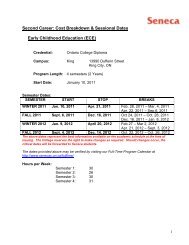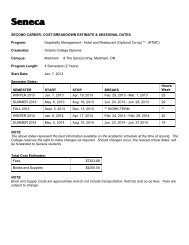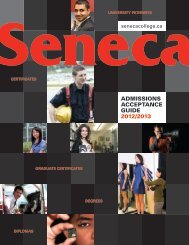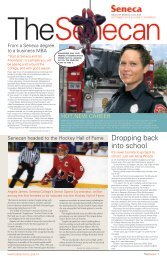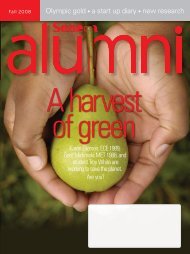2) Presence Build It And They Will Come - Seneca College
2) Presence Build It And They Will Come - Seneca College
2) Presence Build It And They Will Come - Seneca College
Create successful ePaper yourself
Turn your PDF publications into a flip-book with our unique Google optimized e-Paper software.
AFT curriculum and ultimately it would be shown that there was just not<br />
room to house Breezy at the Buttonville hangar. <strong>It</strong> lacked radio equipment<br />
and its very slow speed interfered with the normal circuit traffic at Buttonville<br />
Airport. So, the airport invited the management of Toronto Airways Limited<br />
to request that Breezy no longer operate from Buttonville.<br />
Breezy was sold to the Experimental Aircraft Association of Canada (EAAC)<br />
for $1.00 with an option to <strong>Seneca</strong> to repurchase for the same price at any<br />
time in the future. EAAC would bear the insurance, maintain it, retain the<br />
inspiring <strong>Seneca</strong> insignia and rent the aircraft to all members of EAAC and<br />
the <strong>Seneca</strong> Aeronautics Club for $7.20 per hour (then). This arrangement<br />
extended into free membership for all <strong>Seneca</strong> Aeronautics Club members<br />
(ordinarily $300 per share + $15 per annum + $9 per month flight<br />
insurance) including permission to book any EAAC aircraft on which they<br />
were qualified at any time of the week or weekend, opening up the skies to<br />
<strong>Seneca</strong> flight students…all thanks to their diligence, their evident dedication,<br />
their sure future and, of course, their Breezy. Thus was established those<br />
vital relationships that made <strong>Seneca</strong>’s applicants so plentiful and her<br />
graduates so employable.<br />
Caught up in the spirit of aircraft construction that had infected the entire<br />
course with the success of Breezy, aviation and engineering instructor Robert<br />
A. Froebel (a future co-ordinator of the Aviation program at <strong>Seneca</strong>) went<br />
home one day in 1969 and announced to his sons Eric 7, Michael 9 and Peter<br />
11 that they were going to help daddy build an aircraft in the garage. Those<br />
who came to enjoy the meteoric nature of Froebel over the next quarter<br />
century knew him to be nothing if not intrepid. On Sunday September 28,<br />
1975, following 6 long years of gritty resolution, Froebel and the Thorp 18, C<br />
- Graf were aloft. The aircraft was designed by John W. Thorp of Torrance,<br />
California. <strong>It</strong> was an all-metal, low-wing monoplane capable of carrying two<br />
people. <strong>It</strong> was powered by a Lycoming 180 horsepower engine which would<br />
stall at 60 mph, cruise at 160 and boasted a top speed of 190 mph. After 50<br />
test hours, all restrictions were lifted and the flying Froebels loosed the surly<br />
bonds of Earth.<br />
By 1973, the Aviation and Flight Technology program at <strong>Seneca</strong> was thriving<br />
under the earnest stewardship of the Course Director known to the students<br />
as “The Godfather”, Captain Frank M. Rock who had undertaken the<br />
responsibility in 1970 after having served on the original AFT Advisory<br />
Committee. Rock was into expansion mode. In support of his submission, the<br />
<strong>Seneca</strong> Board, at its May 14 meeting of 1973, directed the <strong>College</strong> to<br />
proceed with the purchase of seven additional aircraft for the program…all to<br />
operate out of Buttonville and all to bear the red, white and black flashings<br />
and the flaming S…now known all over the Metro-centred region as tis pilots<br />
coursed the Toronto skies. Ten of the 37 originals from 1968 had graduated<br />
and, from the freshman class of 1969, 13 of the 49 who started proceeded to<br />
Spring Convocation. Now, in 1973, the 16 survivors from the 53 who began<br />
in 1970 cross the Minkler stage and proceeded into the Air Transport<br />
industry: a grand total of 39. How well was <strong>Seneca</strong> doing in putting its<br />
113




